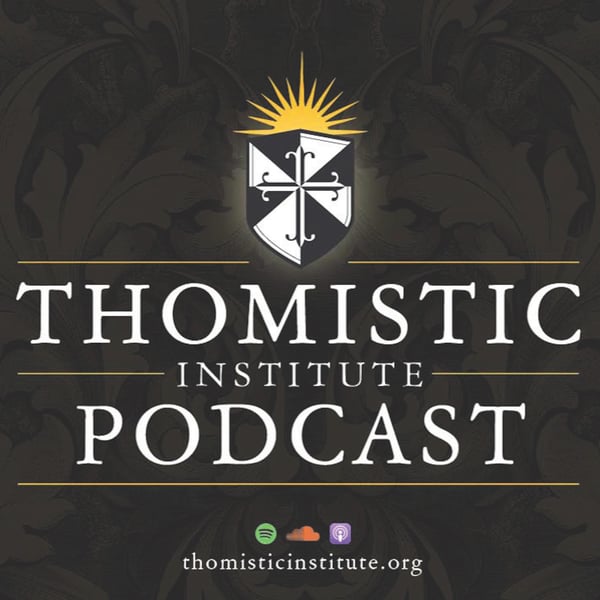What Exactly Is the Hypostatic Union? | Fr. Dominic Legge, O.P.
The Thomistic Institute
The Thomistic Institute
4.8 • 729 Ratings
🗓️ 27 March 2025
⏱️ 41 minutes
🧾️ Download transcript
Summary
Fr. Dominic Legge explores the intricacies of the hypostatic union, focusing on Aquinas's understanding of how the divine and human natures are united in the person of Christ, while navigating various Christological heresies.
This lecture was given on February 24th, 2024, at Dominican House of Studies
For more information on upcoming events, visit us at thomisticinstitute.org/upcoming-events
About the Speaker:
Fr. Dominic Legge is the Director of the Thomistic Institute and Associate Professor in Systematic Theology at the Pontifical Faculty of the Immaculate Conception in Washington, D.C. He is an Ordinary Member of the Pontifical Academy of St. Thomas Aquinas, and holds a J.D. from Yale Law School, a Ph.L. from the School of Philosophy of the Catholic University of America, and a doctorate in Sacred Theology from the University of Fribourg in Switzerland. He entered the Order of Preachers in 2001, after having practiced constitutional law for several years as a trial attorney for the U.S. Department of Justice. He has also taught at The Catholic University of America Law School and at Providence College. He is the author of The Trinitarian Christology of St. Thomas Aquinas (Oxford University Press, 2017).
Keywords: Albert the Great, Christological Heresy, De Unione, Divine Nature, Ephesus, Hypostatic Union, Monophysitism, Nestorianism, Saint Thomas Aquinas
Transcript
Click on a timestamp to play from that location
| 0:00.0 | Welcome to the Tomistic Institute podcast. |
| 0:06.0 | Our mission is to promote the Catholic intellectual tradition in the university, the church, and the wider public square. |
| 0:13.0 | The lectures on this podcast are organized by university students at Tomistic Institute chapters around the world. |
| 0:19.0 | To learn more and to attend these events, visit us at to mystic institute.org. |
| 0:26.3 | Throughout his career, Aquinas spoke about the hypostatic union against the backdrop of two major |
| 0:34.7 | Christological heresies, an historianism that the union in Christ is between two subjects or two persons, |
| 0:42.3 | and monophysitism that the human nature of Christ does not remain distinct from the divine nature. |
| 0:48.3 | We've already been talking about that, so I'm not going to say much more about those. |
| 0:52.3 | But there are some lesser-known Christological errors that were live options in the |
| 1:00.0 | generation before Aquinas, and we don't usually talk about those. |
| 1:04.0 | They set the immediate theological context for Aquinas' thought, and I think that will turn out to be very important. |
| 1:11.9 | The first of these Christological errors goes by the name Christological nihilianism. |
| 1:18.8 | This error was twice condemned by Pope Alexander III, first in 1170 and again in 1177. |
| 1:26.4 | It was associated with the third opinion about the hyposetic union |
| 1:31.6 | in Christ, often called the Havitus theory, that you find in the sentences of Peter Lombard, |
| 1:38.0 | which was then the standard medieval text for the study of theology. This third opinion of Lombard |
| 1:43.8 | tried to avoid the Nestorian heresy |
| 1:47.1 | by saying that the divinity was joined to Christ's body and also to Christ's soul, but that Christ's |
| 1:55.3 | soul and body were not united to each other. And therefore, there's no new person in Christ. But this theory only got to |
| 2:05.0 | this anti-Nistorian conclusion by saying, in effect, that there's also no complete human nature |
| 2:11.5 | in Christ. Pope Alexander called this, and this is text B on your handout, quote, |
| 2:18.2 | the false doctrine of Peter, sometime Bishop of Paris, |
... |
Transcript will be available on the free plan in 1 days. Upgrade to see the full transcript now.
Disclaimer: The podcast and artwork embedded on this page are from The Thomistic Institute, and are the property of its owner and not affiliated with or endorsed by Tapesearch.
Generated transcripts are the property of The Thomistic Institute and are distributed freely under the Fair Use doctrine. Transcripts generated by Tapesearch are not guaranteed to be accurate.
Copyright © Tapesearch 2025.

